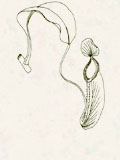
Vertebrates (pdf)
First record of the halfbeak Zenarchopterus striga (Blyth, 1858) in Hong Kong
Department
of Biology, The Chinese University of Hong Kong, Shatin, Hong Kong
tony_nip@yahoo.com
Mangroves are considered to be important nursery grounds for fishes (e.g. Thayer et al., 1987; Sasekumar et al., 1992). Unfortunately, little information is available on fish communities in mangrove habitats in southern China. Because mangrove habitats in many parts of the world are disappearing at an alarming rate (Tam & Wong, 2000; Zhao & Wang, 2000), baseline information on the diversity and species composition of fish communities in mangroves is needed for scientists and managers to devise effective strategies to protect these important and unique habitats for sustainable development.
A detailed study on the fish communities in mangrove waters in eastern Hong Kong was carried out between 2002 and 2003. During the course of the study, halfbeaks were frequently recorded in net samples. The truncated caudal fin and the modified anal fin in males indicate that this halfbeak belongs to the genus Zenarchopterus (Collette & Su, 1986). The occurrence of Zenarchopterus ectuntio in Hong Kong has already been reported (Kottelat et al., 1993). Dr. Bruce Collette (National Museum of Natural History, USA) believes that two other species, Z. dunckeri and Z. buffonis, can also be found in this region (Bruce Collette personal communication). Specimens collected in this study have been identified by Dr. Collette as Z. striga after detailed examination. According to my study, this fish is one of the most abundant species in mangrove and brackish waters in the eastern parts of Hong Kong. Surprisingly, despite its high abundance, the presence of this species in Hong Kong has never been reported. This discovery suggests that there is insufficient information on fish communities in Hong Kong mangrove waters.
I am grateful to Dr. Bruce Collette of the National Museum of Natural History (USA) for his help in fish identification and suggestions.
Bibliography
Collette, B.B. & Su, J. (1986). The halfbeaks (Pisces, Beloniformes, Hemiramphidae) of the Far East. Proceedings of The Academy of Natural Sciences of Philadelphia 138: 250-301.
Kottelat, M., Whitten, A.J., Kartikasari, S.N. & Wirjoatmodjo, S. (1993). Freshwater Fishes of Western Indonesia and Sulawesi. Periplus Editions, Hong Kong.
Sasekumar, A., Chong, V.C., Leh, M.U. & D'Cruz, R. (1992). Mangroves as a habitat for fish and prawns. Hydrobiologia 247: 195-207.
Tam, N.F.Y. & Wong, Y.S. (2000). Hong Kong Mangroves. City University of Hong Kong Press, Hong Kong.
Thayer, G.W., Colby, D.R. & Hettler, Jr.W.F. (1987). Utilization of the red mangrove prop root habitat by fishes in south Florida. Marine Ecology Progress Series 35: 25-38.
Zhao, H. & Wang, L. (2000). Classification of the coastal wetland in China. Marine Science Bulletin 19: 72-82. (In Chinese with English abstract.)
|
|
P.6 |
|
Porcupine! |
 Copyright © 2000 |
